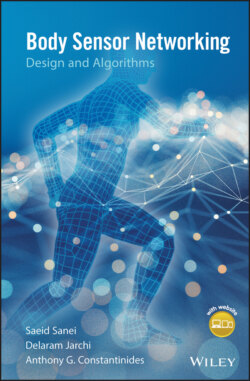Читать книгу Body Sensor Networking, Design and Algorithms - Saeid Sanei - Страница 28
3.2.2 Gyroscope and IMU
ОглавлениеThe gyroscope is arguably the next most commonly used motion detector after the accelerometer. It can be attached to the feet to measure the angular velocity of the foot for detecting different gait phases [28]. The MEMS technology used in accelerometers is used to drive down the cost of gyroscopes, so they are often featured alongside accelerometers in many devices and in IMUs. In contrast to accelerometers, which can directly measure linear acceleration, gyroscopes measure the angular movement about a given axis.
Accelerometers by themselves can measure angular rotation but they cannot give as good a result as gyroscopes, as shown in [29]. Thus, the gyroscope can be used to correct the accelerometer readings, or have its output fused with those of accelerometer when deployed together, such as in an IMU.
The miniaturisation technologies for fibre optic and MEMS progresses quickly. Except for gyroscopes working on optical principles, what the other types have in common is a mass that is constantly moving within the device in order to measure the angular motion. This motion causes the gyroscope to consume more current than an accelerometer. An example of MEMS gyroscope technology is that based on Coriolis acceleration [30]. As opposed to centrifugal acceleration, which is always present in rotation, Coriolis acceleration occurs whenever there is motion along the radius of the rotation.
Figure 3.3 shows the schematic of a single axis of a gyroscope which rotates clockwise, together with its semiconductor substrate. The gyroscope has capacitive fingers fabricated as part of its structure [20]. To this substrate a frame with a set of capacitive fingers is tethered with springs. In addition, a mass, also tethered to this frame with springs, is driven into mechanical resonance and constrained to move in one direction. On the left of the figure, the mass is considered as it moves to the top of the figure along the radius of rotation. The Coriolis force acts on the frame, which deflects to the left as shown. On the right of the figure, as the mass resonates it moves to the bottom of the figure; in this case the Coriolis force causes a deflection to the right. The varying distance between the capacitive fingers is picked up as a voltage representing a measure of the angular speed. From [29], it can be shown that the displacement of the frame relative to the substrate is [20]:
Figure 3.3 A simple diagram of a gyroscope rotating clockwise. On the left, resonating mass is moving upwards, whereas, on the right, it is moving downwards. Direction of Coriolis force is also shown [20].
Source: Courtesy of Jarchi, D., Pope, J., Lee, T.K.M., Tamjidi, L., Mirzaei, A. and Sanei, S.
where Ω is the angular velocity of the gyroscope (towards the right) and v the velocity of the resonating mass along the radius of rotation, M is mass, k is the spring constant of the frame-substrate springs. By driving the resonating mass at a known frequency, its changing displacement D induces a voltage from which the angular speed can be derived reasonably linearly. However, as with MEMS devices, the problems of drift, noise, and other artefacts remain. An IMU can be a combination of both accelerometers and gyroscopes (and a magnetometer in a 9D version) that measures rate, angle, and direction of motion. IMUs can be attached to any part of the body and are effectively used in gait analysis. Recent IMUs have built-in magnetometers as well that sense gravity and can be used in fall detection.
